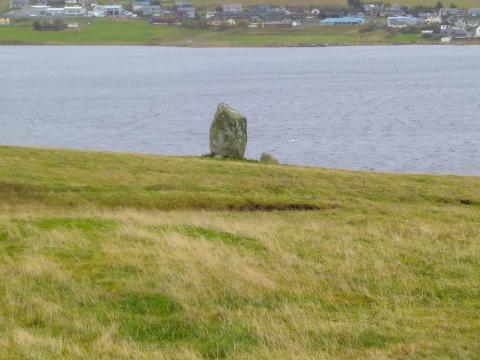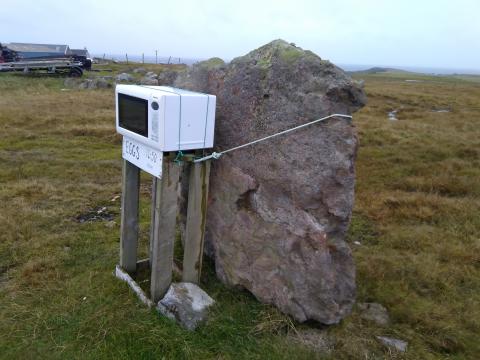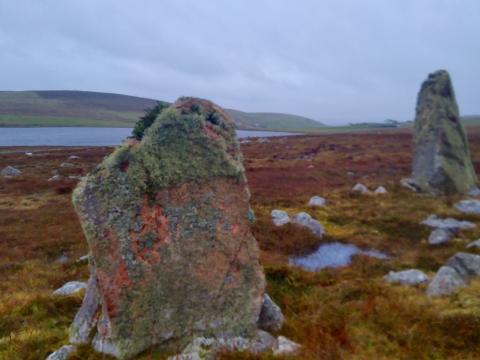Standing Stones of Shetland

Despite the rains and the wind, I enjoyed trooping round the Shetland mainland this week seeking ancient standing stones. These are long, artificially erected monoliths of indeterminate age, but they are thought to go back 2000- 3000 years before the birth of Christ. Their purpose is unclear; some suggest they are ancient boundary markers, sites for gatherings and parliaments, markets or maybe landmarks to guide home fishing vessels. Whatever objective their makers had in mind, they went to great effort, considering the depth these stones require to stand upright so long. Unlike the stone circles of Aberdeenshire which I visited this year, I could see no artistic carving upon them.

One stone had been given a more modern purpose by local crofters. Secured by a rope was a microwave, inside which were some boxes of eggs for sale at £1.50 per half-dozen. The rope kept it from blowing away and the old kitchen appliance kept the eggs dry. Attached to other standing stones are myths and legends, rather less useful than a microwave but more interesting. Some are calle Giants’ Stones and said to be some over-sized chap’s resting place. Despite the legends and air of mystery, these stones bespeak early man’s compliance, if not obedience, to the Creator. After the great flood in Genesis chapter 9, God reaffirms His command to Adam:
So God blessed Noah and his sons, and said to them: “Be fruitful and multiply, and fill the earth”.
In chapter 11 verse 4, however, Noah’s fallen families scheme to the contrary:
“Come, let us build ourselves a city, and a tower whose top is in the heavens; let us make a name for ourselves, lest we be scattered abroad over the face of the whole earth.”
They attempted to defy God’s decree by concentrating together (political and economic power) and attempting to gain their own admission to heaven (religious and theological power). God found both to be obnoxious, and confused their language, dispersing them over the planet. What they refused to do voluntarily, God forced their hand. That some descendants of Japheth finally travelled as far north as Shetland was an act of submission to God’s revealed will. Among these bleak hills and barren voes, large stones were erected, silent witnesses to their arrival and compliance with divine law. Whether these stones were miniatures towers of Babel, petty ascents to heaven and places of pagan ritual, we cannot tell. That they demonstrate God’s intention that man covers the earth, we may be certain.

In Philippians 2:9-11, the apostle writes that all people will acknowledge that lordship of Jesus Christ:
Therefore God also has highly exalted Him and given Him the name which is above every name, that at the name of Jesus every knee should bow, of those in heaven, and of those on earth, and of those under the earth, and that every tongue should confess that Jesus Christ is Lord, to the glory of God the Father.
Some of us do so now, joyfully and sincerely; most will only do so on that great Day, when He comes from the heavens. They too shall glorify Him sincerely, for their artifice shall be exposed and their lies laid bare. Sincerely, but not joyfully, for they shall await His judgement. Whether it be the command of Genesis 9, or the command of Psalm 2:12 (‘Kiss the Son, lest He be angry, and you perish in the way’), God’s will shall be honoured one way or another. Shetland’s standing stones bear testimony to this.

- Log in to post comments


 Sunday Worship 10.45am & 6.00pm
Sunday Worship 10.45am & 6.00pm